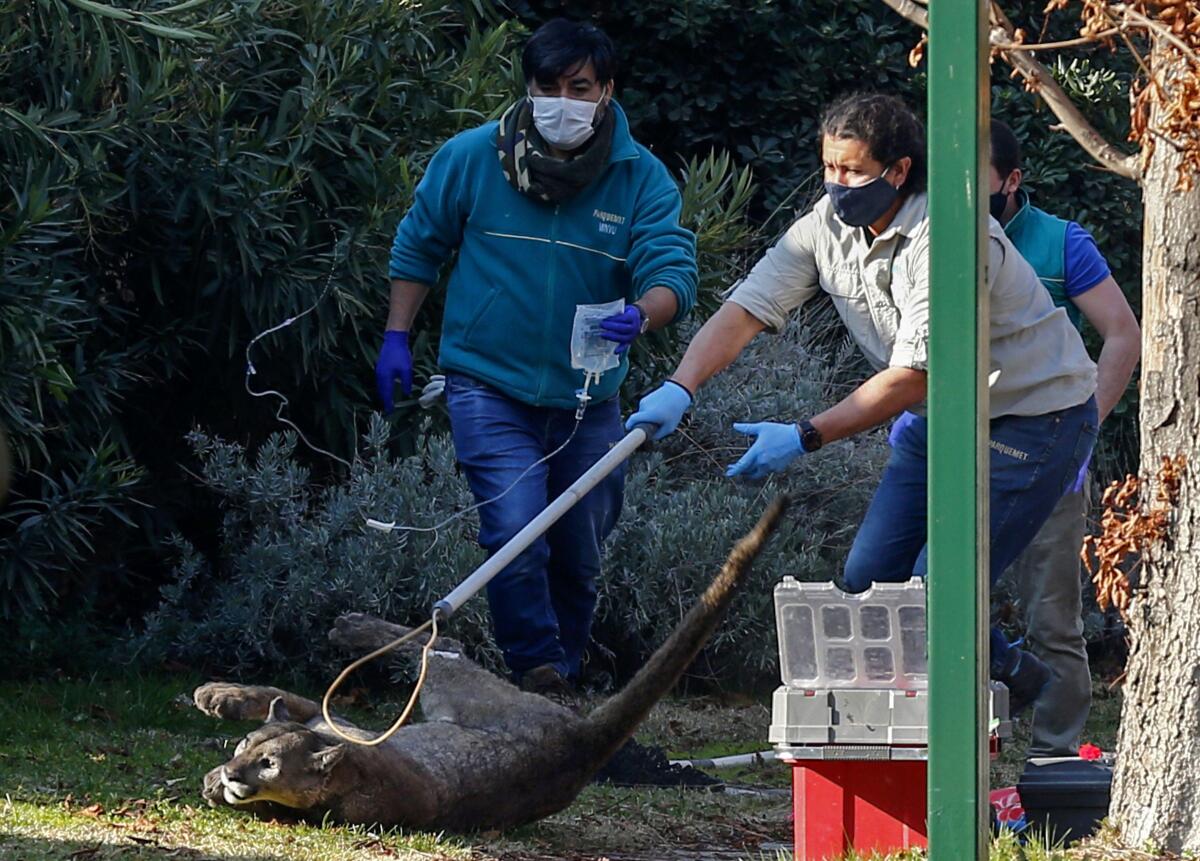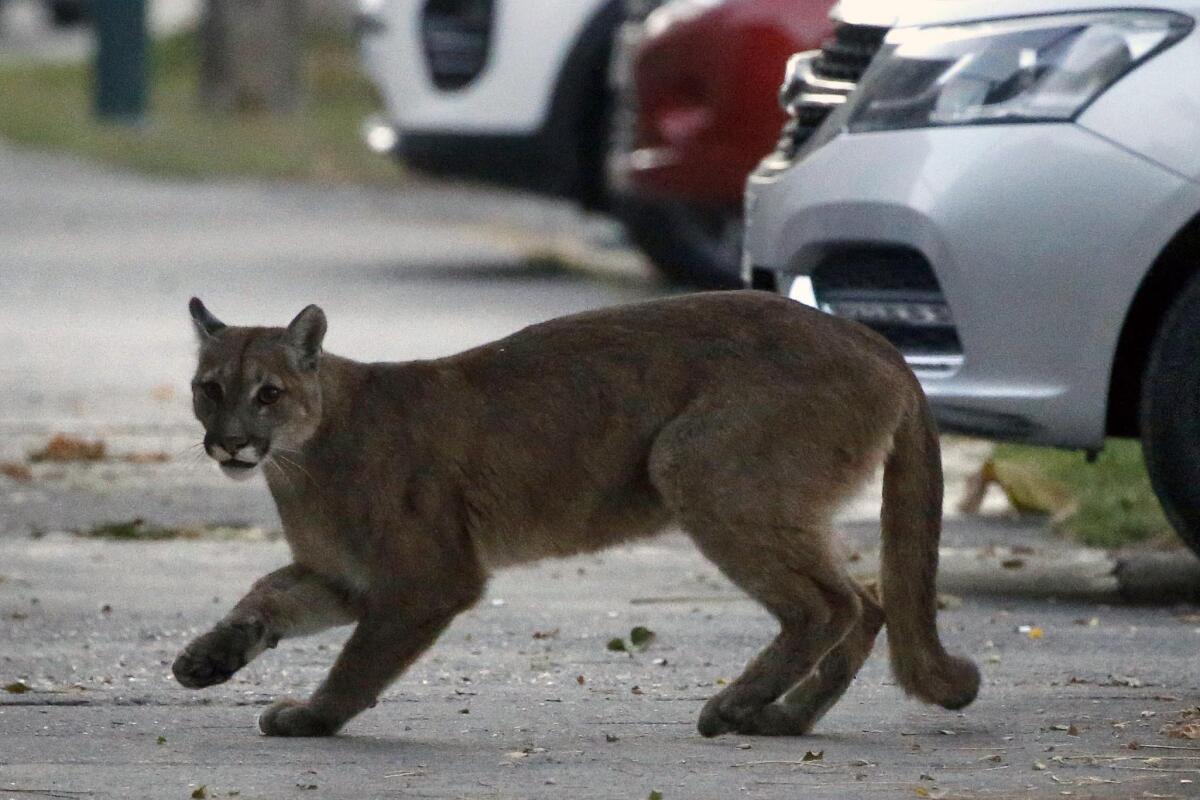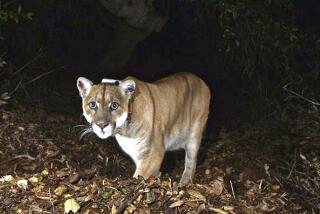Mountain lions on the streets: Chilean capital sees influx of big cats amid lockdown

- Share via
SANTIAGO, Chile — The big cat was first spotted sniffing in a backyard in the affluent Lo Barnechea neighborhood.
“He started running toward me, trying to escape, so I took the shot, but the dart needle broke on his back leg,” recalled Julio Bustamante, an animal control officer summoned to the scene one afternoon last month.
The nimble feline jumped a wall and scampered away, trailed by TV crews and neighbors with cellphones recording the scene.
The cat — later determined to be a 97-pound adult male mountain lion — was finally cornered in the bushes on a nearby street, where Bustamante shot him twice more with tranquilizing darts, putting him to sleep.
Here in the Chilean capital, home to 7 million people, an overnight curfew imposed more than five months ago to curtail the COVID-19 pandemic has had an unanticipated side effect: nocturnal incursions by mountain lions onto suburban and city streets, now largely devoid of nighttime traffic and noise.
Since the curfew, which runs from 11 p.m. (pushed last month from 10 p.m.) to 5 a.m.,
took effect in March, authorities have captured seven mountain lions — or pumas, as they are known here — roaming the capital and environs. Only two such captures occurred in all of 2019, well before the government moved to battle the pandemic that has killed more than 11,000 in the South American nation.
Six of the seven captured cats were tranquilized and returned to the wild after medical evaluations, officials say. All six were outfitted with microchips facilitating identification if they are encountered again; one was also fitted with an electronic GPS collar to aid in studies of behavior and travel patterns. A seventh, a female in ill health, remained under observation at the national zoo’s wildlife rehabilitation center.

Mountain lion encounters in the capital have become a new normal, regularly documented on social media and in the press. Surveillance video, cellphone footage and witness accounts all suggest that additional pumas are likely on the loose, prowling about town.
Across the globe, coronavirus stay-at-home orders have spawned breathless stories of wildlife boldly venturing into deserted urban areas, some of the accounts apocryphal — like those dolphins supposedly cavorting in newly pristine Venetian canals.
But the puma visitations in Santiago are real, as are periodic sightings of cougars in the Los Angeles area, another place where mountainous habitat abuts suburban development. Last year, residents of a Simi Valley neighborhood expressed alarm after a mountain lion attacked two dogs, killing one, and was seen roaming the area. Meanwhile, in June, a young mountain lion was captured in downtown San Francisco, where it had been seen roaming the streets and napping in a planter box.
In California, vehicular collisions have been a major source of mountain lion mortality. A June study by researchers at UC Davis found that reduced traffic from stay-at-home orders beginning in March likely contributed to a 58% reduction in road deaths of mountain lions in California.
In Santiago in normal times, a 112-mile grid of highways in and around the city deters Chile’s top predator from urban forays. But a quieter and darker metropolis has encouraged some of the hunters to make their way into town from their mountain abodes.
“As in California, central Chile’s pumas are mainly nocturnal animals, and traffic creates impenetrable barriers for them to cross without being run over,” said Cristián Bonacic, a veterinarian and wildlife professor at the Catholic University of Chile. “So when traffic drops to nearly zero, they start traveling to urban areas.”
No pandemic-era attacks on humans have been recorded, and there has been only one reported case of a dog being eaten. Officials have advised residents to keep pets indoors when puma sightings are reported.
Pumas are a protected species in Chile. Illegal hunting of the predators can land violators in prison for five years.
Santiago’s first puma alert came March 24, two days after the nighttime curfew was declared.
A resident’s tip led animal control personnel to a garage in Ñuñoa, a middle-class neighborhood five miles southeast of Santiago’s central Plaza de Armas, where Spaniards founded the capital in 1541, at the foot of the Andes Mountains.
Called to the scene was Bustamante, 47, who has tranquilized six of the seven big cats caught this year in the Santiago area.
“I got to the garage, crawled under the car, turned the flashlight on, and there he was, looking right at me,” recalled Bustamente. “His ears went back, and [he] showed me his teeth a little.”
It took Bustamente two shots with the tranquilizing dart to hit the target.
The Ñuñoa mountain lion, which weighed in at 68 pounds, was the first of four males, three of them juveniles, that have been snagged this year in the Santiago area. The largest was the 97-pound adult that Bustamante tranquilized last month in the bushes of Lo Barnechea. The females captured were two juveniles and an adult.
Santiago’s noise pollution has declined by 75% since the curfew was imposed, according to a survey by the Autonomous University of Chile. While the lack of urban racket and lights are drawing the pumas, precarious environmental conditions also help explain the intrusions, experts say. A drought lasting more than a decade has reduced prey in the cats’ mountainous terrain, prompting some to risk descending from higher elevations and approaching populated areas, including suburbs that have pushed up against the foothills of the Andes.
Suburban sprawl and an attendant proliferation of lawns have drawn rabbits and hares — tempting morsels for the cats. “Many herbivores like rabbits are increasing in numbers in the green-grass suburbs,” said Horacio Bórquez, Chile’s national director of agricultural and livestock service.
Most pumas have turned up in tony districts, a fact that has led to some teasing repartee on social media.
“Equal distribution of pumas,” one resident of a puma-less Santiago neighborhood demanded on Twitter.
The infiltrators have inspired more wonder and curiosity than fear, perhaps because no attacks have been reported. For many, a close encounter with a mountain lion has been an awe-inspiring experience.
“Imagine seeing such an impressive animal in your backyard — it was crazy,” said Verónica Stange, a civil engineer and mother of two, of the mountain lion spotted April 2 outside her home in Chicureo, an affluent suburb north of Santiago. “Animals see a calm city, and they come down to hunt. It’s as simple as that.”
The cat she saw — an 8-year-old female, it turned out — was dehydrated, weighing only 48 pounds and bleeding from the snout, medical records show. Her bottom canine teeth were broken off, and she had a snare wire embedded in a paw. Unlike other captured mountain lions, which are quickly released, she remained under observation and treatment.
Six days later, another big cat was spotted in the same Chicureo suburb. This time, neighbors used a cage to trap the 73-pound juvenile male with a “bulging stomach” from “digesting a dog carcass,” medical records showed. Authorities are investigating whether it hunted the unfortunate dog or if someone put the canine in the cage as bait, which would be illegal.
The puma sorties will likely abate once the lockdown ends and life in the Chilean capital returns to its customary clamor and bustle, experts say. But some big cats will inevitably continue slipping into the city under the cover of night, seeking prey no longer abundant in their Andean enclaves.
“Mountain lions were here before us here in this city. We are the ones who have invaded their habitat,” Alejandra Montalba, director of Chile’s National Zoo, said this month at a conference on Instagram Live. “We already know that this is going to keep happening.… Encounters with wildlife are here to stay.”
Special correspondent Poblete reported from Santiago, and Staff Writer McDonnell reported from Mexico City.
More to Read
Sign up for Essential California
The most important California stories and recommendations in your inbox every morning.
You may occasionally receive promotional content from the Los Angeles Times.










